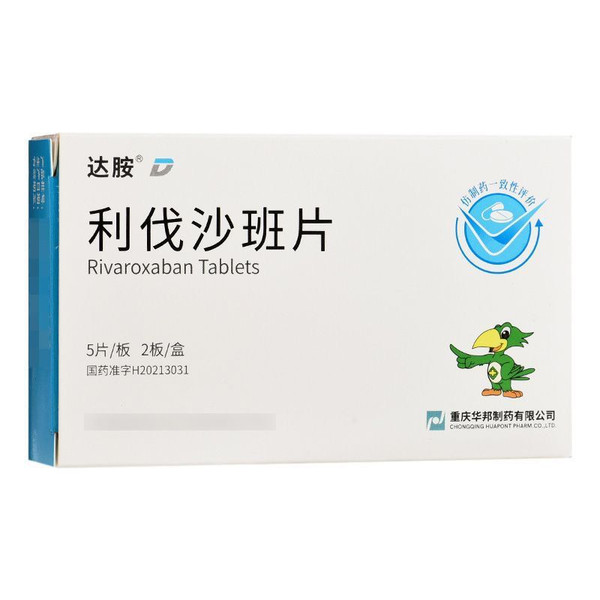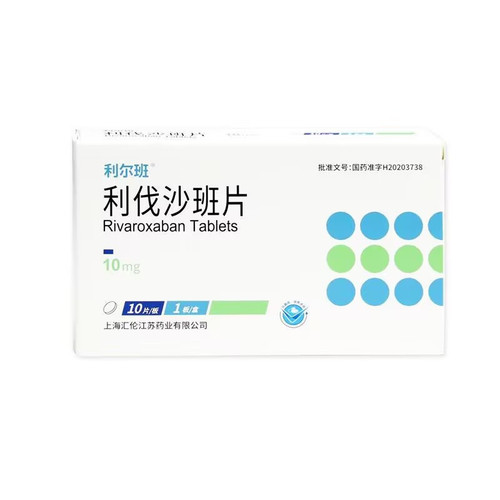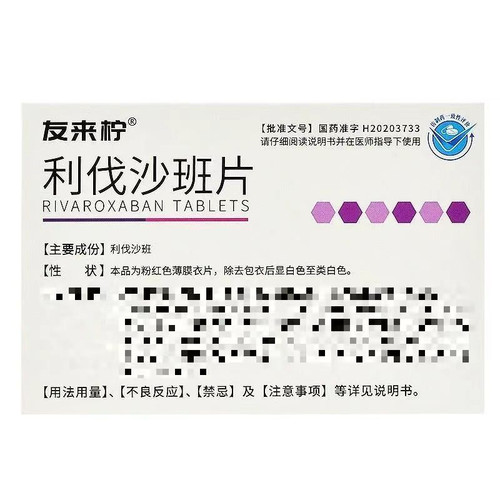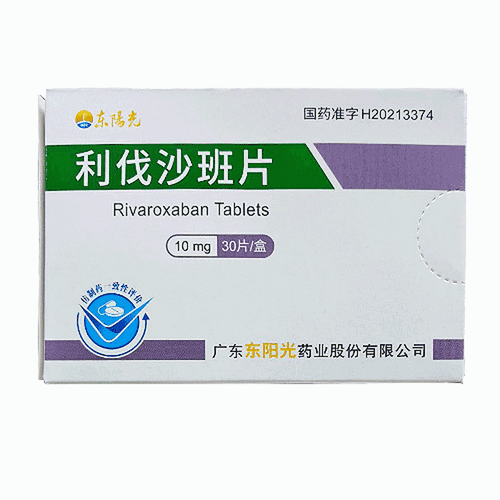Product Overview
[Drug Name]
Generic Name: Rivaroxaban Tablets
Trade Name: Rivaroxaban Tablets 10mg x 10 Tablets
[Main Ingredient]
Rivaroxaban.
[Properties]
This product is a light red film-coated tablet that appears white after removal of the coating.
[Indications/Main Functions]
1. For the prevention of venous thrombosis (VTE) in adult patients undergoing elective hip or knee replacement surgery. 2. For the treatment of deep vein thrombosis (DVT) in adults, reducing the risk of DVT recurrence and pulmonary embolism (PE) after acute DVT. 3. For the reduction of the risk of stroke and systemic embolism in adult patients with non-valvular atrial fibrillation and one or more risk factors (e.g., congestive heart failure, hypertension, age ≥75 years, diabetes, history of stroke or transient ischemic attack).
[Specifications]
10mg x 10 tablets
[Dosage and Administration]
1. The recommended dose is rivaroxaban 10mg orally once daily. If wound bleeding has stopped, the first dose should be taken between 6 and 10 hours after surgery. The length of treatment depends on each patient's risk of venous thromboembolism, specifically the type of orthopedic surgery they undergo. For patients undergoing major hip surgery, a 5-week treatment course is recommended. For patients undergoing major knee surgery, a 2-week treatment course is recommended. If a dose is missed, patients should immediately take rivaroxaban and continue taking it once daily the following day. Patients can take rivaroxaban with or without meals.
[Adverse Reactions]
The safety of rivaroxaban 10 mg was evaluated in three Phase III studies. A total of 4,571 patients undergoing major lower limb orthopedic surgery (total hip replacement or total knee replacement) received rivaroxaban for up to 39 days. Approximately 14% of treated patients experienced adverse reactions. Bleeding and anemia occurred in approximately 3.3% and 1% of patients, respectively. Other common adverse reactions include nausea, increased glutathione (GT), and elevated transaminases. Adverse reactions should be interpreted in the context of the procedure. Due to its pharmacological mode of action, rivaroxaban may increase the risk of occult or overt bleeding in some tissues or organs, potentially leading to posthemorrhagic anemia. Signs, symptoms, and severity of bleeding (including potential fatal outcomes) will vary depending on the site, degree, or extent of bleeding. The risk of bleeding may be increased in certain patient groups, such as those with uncontrolled severe arterial hypertension and/or those taking concomitant medications that affect hemostasis. Hemorrhagic complications may manifest as weakness, asthenia, pallor, dizziness, headache, or unexplained swelling. Therefore, the possibility of bleeding should be considered when evaluating patients receiving anticoagulants. Table 1 below lists adverse reactions from the three phase I studies by system organ class (MedDRA) and frequency. Frequency definitions are as follows: Common: >21/100 to <1/10. Uncommon: ≥1/1,000 to <1/100. Rare: >1/10,000 to <1/1,000. Unknown: No estimate can be made based on available data.
[Contraindications]
1. Patients with hypersensitivity to rivaroxaban or any of the excipients in the tablets. 2. Patients with clinically significant active bleeding. 3. Patients with liver disease with coagulation abnormalities and a risk of clinically relevant bleeding. 4. Pregnant and lactating women.
[Drug Interactions]
See the package insert for details.
[Precautions]
See the package insert for details.
[Pediatric Use]
Due to the lack of safety and efficacy data, rivaroxaban tablets are not recommended for use in adolescents or children under 18 years of age.
[Elderly Use]
No dose adjustment is required for elderly patients (>65 years of age).
[Overdose]
1. Absorption: The absolute bioavailability of 10 mg of rivaroxaban is high (80%-100%). Rivaroxaban is rapidly absorbed, reaching maximum concentration (Cmax) 2-4 hours after administration. Food has no significant effect on the AUC or Cmax of a 10 mg rivaroxaban tablet, so the timing of administration of a 10 mg rivaroxaban tablet is not restricted by meals. The pharmacokinetics of rivaroxaban are generally linear up to a dose of approximately 15 mg once daily. At higher doses, rivaroxaban exhibits dissolution-limited absorption, with bioavailability and absorption decreasing with increasing dose. This phenomenon is more pronounced in the fasted state than in the fed state. The pharmacokinetics of rivaroxaban are moderately variable, with inter-individual variability (CV%) ranging from 30% to 40%, but variability is higher (70%) in exposure on the day of surgery and the first postoperative day. 2. Distribution: Rivaroxaban is highly bound to plasma proteins (primarily serum albumin), approximately 92% to 95% in humans. The volume of distribution is moderate, with a steady-state volume of distribution of approximately 50 liters. 3. Metabolism and elimination: (1) About 2/3 of the dose of rivaroxaban is metabolized and degraded, and then half is excreted through the kidneys and the other half is excreted through the feces. The remaining 1/3 of the dose is excreted directly through the kidneys in the urine in the form of the active drug prototype, mainly through active secretion by the kidneys. (2) Rivaroxaban is metabolized by CYP3A4, CYP2J2 and CYP-independent mechanisms. Oxidative degradation of the morpholinone moiety and hydrolysis of the amide bond are the main biotransformation sites. In vitro studies have shown that rivaroxaban is a substrate for the transport proteins P-gp (P-glycoprotein) and Bcrp (breast cancer resistance protein). (3) The rivaroxaban prototype is the most important compound in human plasma, and no major or active circulating metabolites have been found. The systemic clearance of rivaroxaban is approximately 10 L/h, making it a low-clearance drug. The elimination half-life after intravenous administration of 1 mg is approximately 4.5 hours. The clearance after oral administration of 10 mg is limited by absorption rate, with an average elimination half-life of 7 to 11 hours. 4. Elderly use (>65 years)/gender: Elderly patients have higher plasma concentrations than younger patients, with average AUC values approximately 1.5 times that of younger patients, mainly due to (significantly) reduced total clearance and renal clearance in elderly patients. No dose adjustment is required. There are no gender differences in pharmacokinetics and pharmacodynamics. 5. Body weight differences: Extreme body weight (<50 kg or >120 kg) has only a slight effect (less than 25%) on the plasma concentration of rivaroxaban, and no dose adjustment is required. 6. Racial differences: No clinically significant racial differences in the pharmacokinetics and pharmacodynamics of rivaroxaban were observed in white, African American, Hispanic, Japanese or Chinese patients.
[Pharmacology and Toxicology]
1. Pharmacological action (1) Rivaroxaban is a highly selective, oral drug that directly inhibits factor Xa. By inhibiting factor Xa, rivaroxaban interrupts the intrinsic and extrinsic pathways of the coagulation cascade, inhibiting thrombin generation and thrombus formation. Rivaroxaban does not inhibit thrombin (activated factor I) and has not been shown to affect platelets. (2) A dose-dependent inhibitory effect of rivaroxaban on factor Xa activity has been observed in humans. The effect of rivaroxaban on prothrombin time (PT) is dose-dependent and closely correlated with plasma concentrations when measured with NeopLastin® (correlation coefficient 0.98). Different results may be obtained using other reagents. The PT should be read within seconds because the international normalized ratio (INR) is only calibrated and validated for coumarins and cannot be used for other anticoagulants. In patients undergoing major orthopedic surgery, 2-4 hours after taking the tablet (when the effect is strongest), the PT of the 5/95th percentile was (NeopLastin®) 13-25 seconds (baseline value before surgery was 12-15 seconds). 3) Prolongation of the activated partial thromboplastin time (aPTT) and HepTest is also dose-dependent; however, it is not recommended for use in evaluating the efficacy of rivaroxaban. Rivaroxaban also has an effect on the activity of factor Xa, however, there is currently no calibration standard. Monitoring of coagulation parameters is not required during routine clinical use of rivaroxaban. 2. Toxicological studies (1) Based on traditional safety pharmacology, single-dose toxicity, phototoxicity, and genotoxicity studies, non-clinical data showed no special harm to humans. The effects observed in repeated-dose toxicity studies were mainly due to the extended pharmacodynamic activity of rivaroxaban. In rats, increased IgG and IgA blood concentrations were observed at clinically relevant blood concentrations. (2) Animal studies have shown reproductive toxicity related to the pharmacological mechanism of action of rivaroxaban (e.g., bleeding complications). Embryo-fetal toxicity (post-implantation loss, delayed/progressive ossification, multiple light-colored spots on the liver) and increased incidence of common malformations and placental changes were observed at clinically relevant blood concentrations. In prenatal and postnatal studies in rats, reduced offspring viability was observed at doses that were maternally toxic.








